
Normalizing Volume in VLC A Step-by-Step Guide for 2024

Normalizing Volume in VLC: A Step-by-Step Guide
How To Normalize Volume in VLC
How to normalize volume, why should we do it, and what is it after all? – these are the questions when it comes to editing our audio files, as well as the video clips we tend to change the sound of. So, first of all, the volume normalization is pretty much explained as follows: The process when a constant amount of gain is applied to the audio recording, bringing the amplitude to a desirable level, which is “the norm” for the project. If it is a little bit difficult to understand, we have to highlight that when this tool is applied to our volume, the whole recording has the same amount of gain across it, every piece affected the same way. Accordingly, when we normalize volume, the relative dynamics are not changed.
But, why bother at all and why not leave it the way it is? Well, the answer to this is almost the same as on why editing exists in general, right? Things are not perfect! This is the fact that prompts us to make our video clips and audio better, improve it at least on the level which can get us the right amount of viewers and listeners. Everyone have had some pain listening to several podcasts, when the volume was too high or too low, or there were so much background noise that the whole recording was hurting the ears of a person! People will not convert to being loyal subscribers, viewers and listeners if their user experience is not favored. So, it is in our best interest to serve their best interest, with a little bit of editing.
When it comes to normalizing audio, there are two reasons we refer to this tool. First is when we feel we need to get the maximum volume, and the second is when we need to match different volumes.
In the first case, you might have somewhat quite voice recording, and would like to make it better without changing its dynamic range, while making it as loud as possible. And when it comes to matching volumes, it is logical that you need to manipulate your editing this way in case you have a group of audio files, each or some of them are at different volumes, so, understandably, if not necessarily, you would like to make them come closer to the same volume.
So, until we give you the step-by step guide on how to normalize your volume in VLC player, we also need to inform you about audio normalization types. Here, generally, we come across three of them: a so-called peak normalization, helping adjust the recording based on the highest signal level present in the recording; another is called loudness normalization and it adjusts the recording based on perceived loudness. Last but not least, RMS (Root-Mean-Square), changes the value of all the samples, where their average electrical volume overall is a specified level.
Using any of this, making it better to listen to your voice, without people being annoyed and their ears becoming exhausting with what you have to offer, you will be making it enjoyable for them and easy to come back to your content, as they will not be obliged to change the volume on their own audio players. Instead, their experience with you will be calm and effortless, which you are aiming to achieve.
So, not, what about VLC? – this is a very popular media player, favorite for a lot of people all around the world, so you should already be quite familiar with what it is, at least by having streamed videos and movies there. Speaking more of what it represents, it is a free-to-use, robust, and feature-packed software that plays a wide range of audio, image, and video files. It is worth noting that it can also play multimedia files directly from extractable devices or the PC and additionally, the program can stream from popular websites such as Disney+, Hulu, Netflix, and so on.
As if it was not enough, you can do simple video and audio editing in VLC Media Player, which a lot of people are unaware of! For example, you can easily trim and cut videos. So, as it happens, we can also normalize volume in VLC Media Player. It is a very handy feature and it works on Windows as well as on Mac. Sooo… How to do that? Because, actually, it is so simple that you might be surprised you didn’t know about this earlier. To learn how to normalize volume in VLC, follow this simple guideline:
First, of course, as every time working with any software, you need to have VLC Media Player installed on your device. Once you have it installed, open VLC. Go to the Tools and Preferences and there, you will need to check the single box which is next to Normalize volume in Effects. Now, set the level to the one that works best for you. Then, when you are happy with the result, you can Save.
This is not something perfect, because it’s so simple to do and actually what it does is just help adjust the general volume, so it leaves the specifics alone.
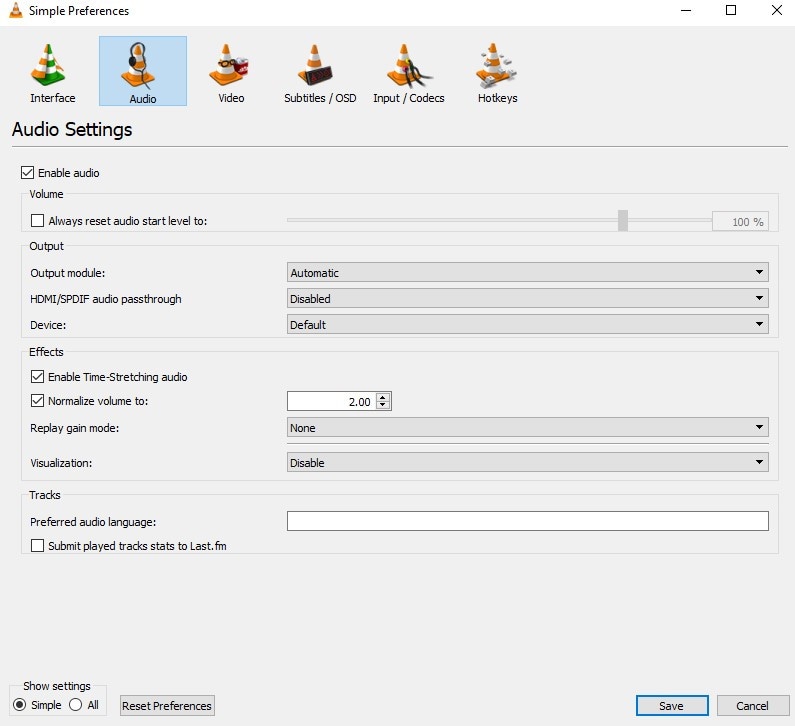
But, it might be the case that you are not so satisfied with the simple editing and want a little more to get from the editing process on VLC. So, you can do more with the Audio Effects menu there. And the steps are as follows:
First, on your VLC player, find Tools and then, in the menu, go to Preferences. The window will open, and there you need to select All in Show settings – actually it is a little bit hard to find because this is in the bottom left corner of the window. From there, you will need to navigate to Audio, and then, a little below, click on Filters and highlight it. The checkbox next to the Dynamic range compressor will probably be unchecked – so, check in it.
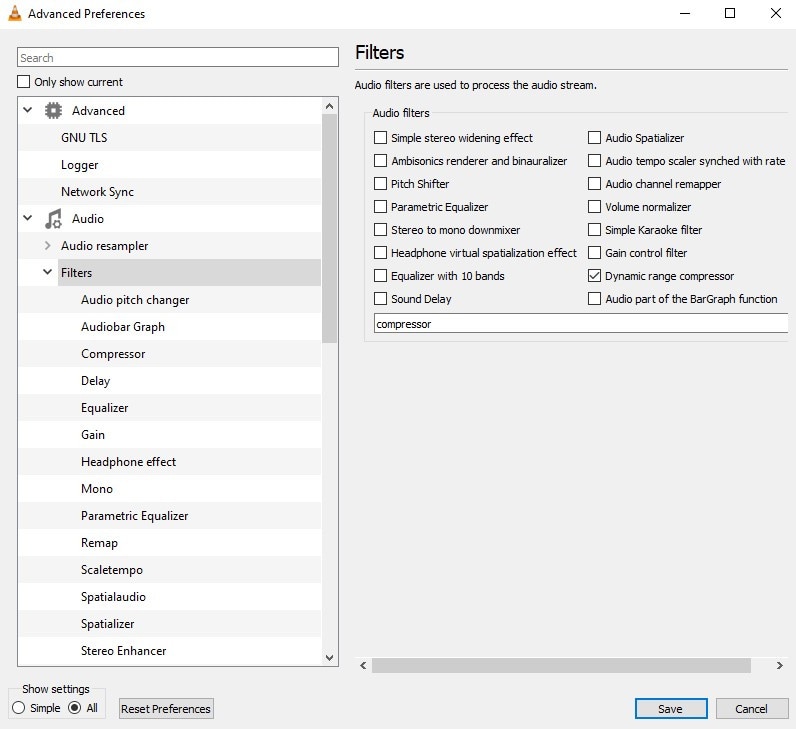
Next, see where Compressor is in the left panel? Select it. And now, you are free to make the changes to the levels as you see fit.
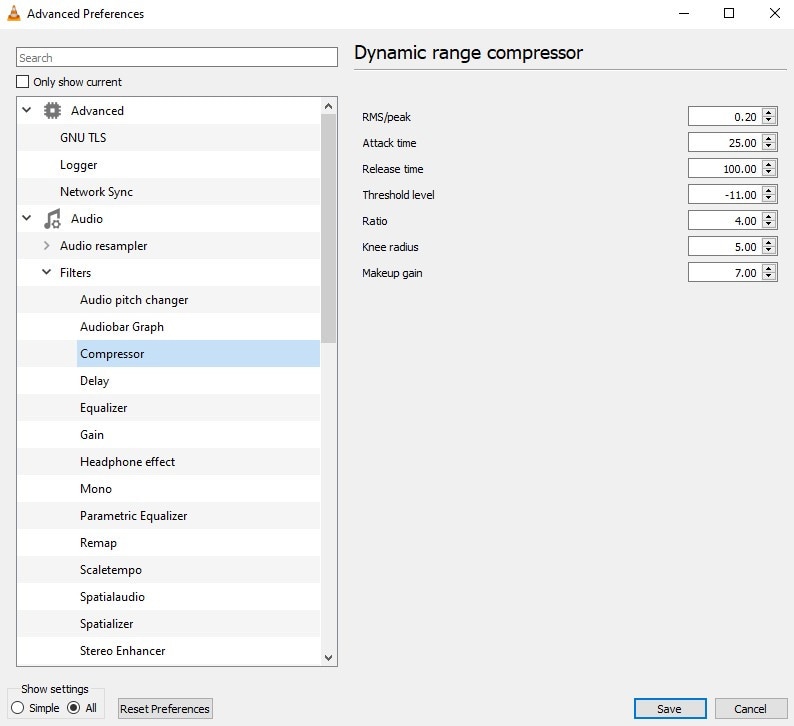
Here, if you are a little bit overwhelmed with the wide range of options to work on, you can just concentrate the most on Makeup gain, Threshold, and Ratio. The first one is by which you adjust in quiet sequences to raise the volume, the second will help you reduce louder sequences to even things out, and ratio is the maximum level of all audio within a movie, let’s say.
Don’t underestimate Attack time and release time, either. They graduate the changes to ramp them up at first, then down again, rather than initiating them immediately. So, if you set them to your liking as well, this will ensure that you have a more fluid transition in and out of the scene and there are less sudden, sometimes scary volume changes.
Therefore, you are now equipped with the most information you will need to normalize volume in VLC Player – so free to give it a go, play around with the different settings and carry out the best result imaginable for you!
How to normalize audio in Wondershare Filmora?
Now, even though we already know how to normalize audio in VLC in the simplest, as well as in the more advanced way, it might be even better if we know some more about normalizing audios in different programs. Something worth discussing is a software called Wondershare Filmora , which carries out the same task wonderfully. Although, unlike VLC Media Player, it is a real video editor , but don’t panic if you have never laid your hand on editing – it is one of the easiest to use ini the word, operating also both on Mac and Windows, and its interface is utterly understandable for beginners right away. And, actually, it is a qhile that Wondershare Filmora X introduced the feature to normalize the audio for the first time. What to say more - you might want to stop now and download the latest version of Filmora because now we are about to learn how to normalize audio from the video there – so, tune in!
Free Download For Win 7 or later(64-bit)
Free Download For macOS 10.14 or later
When it is done installing, open the software. Now, click and drag the video of which the audio you want to normalize. Now you can select the clip you have chosen – if there are multiple, select all of them, then right-click and choose Detach Audio.
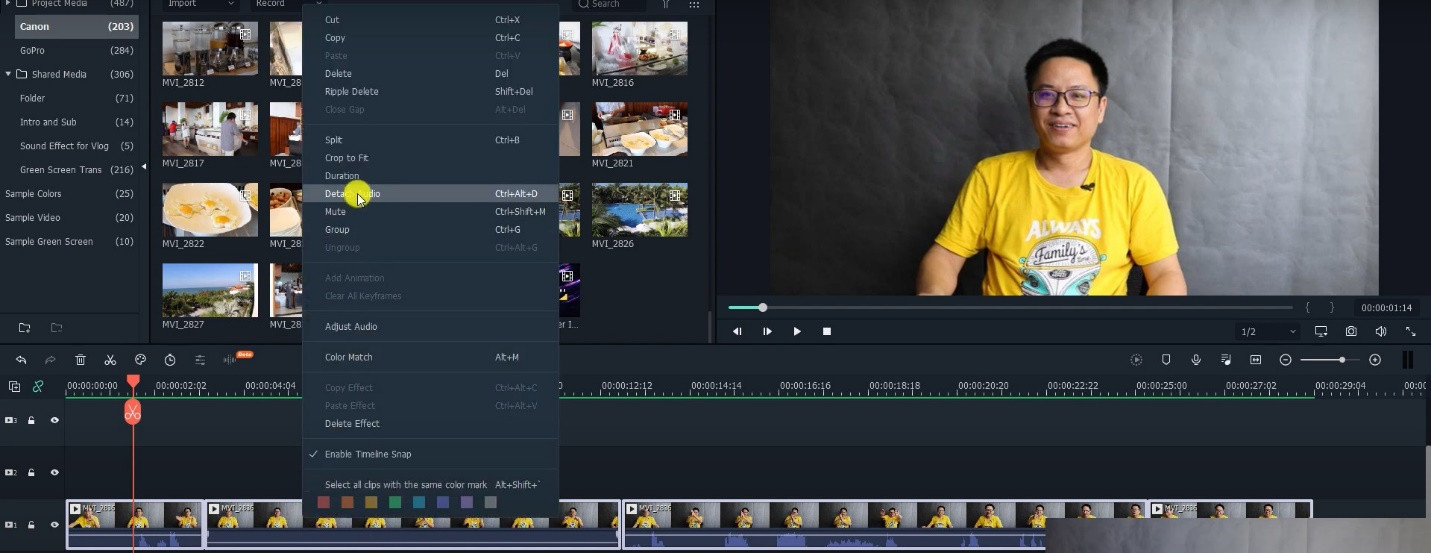
Now if you have this kind of graphic before your eyes, you can be pretty sure without even listening, that the noises are really, really different from each other, which highlights once again how useful audio normalization can be:

Select these files, right-click and choose Adjust Audio. New panel will be opened on left top and there, you will see Audio Normalization – check the box there.
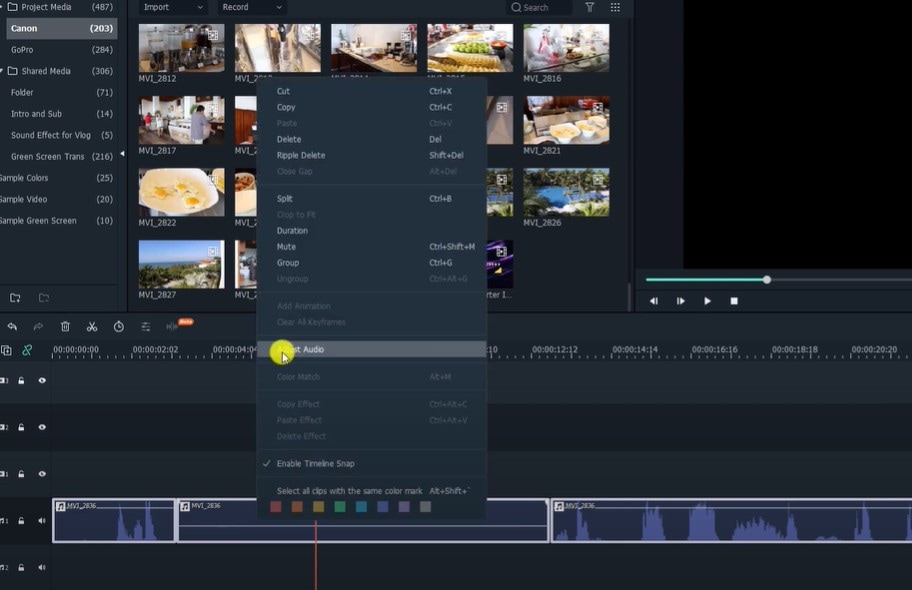
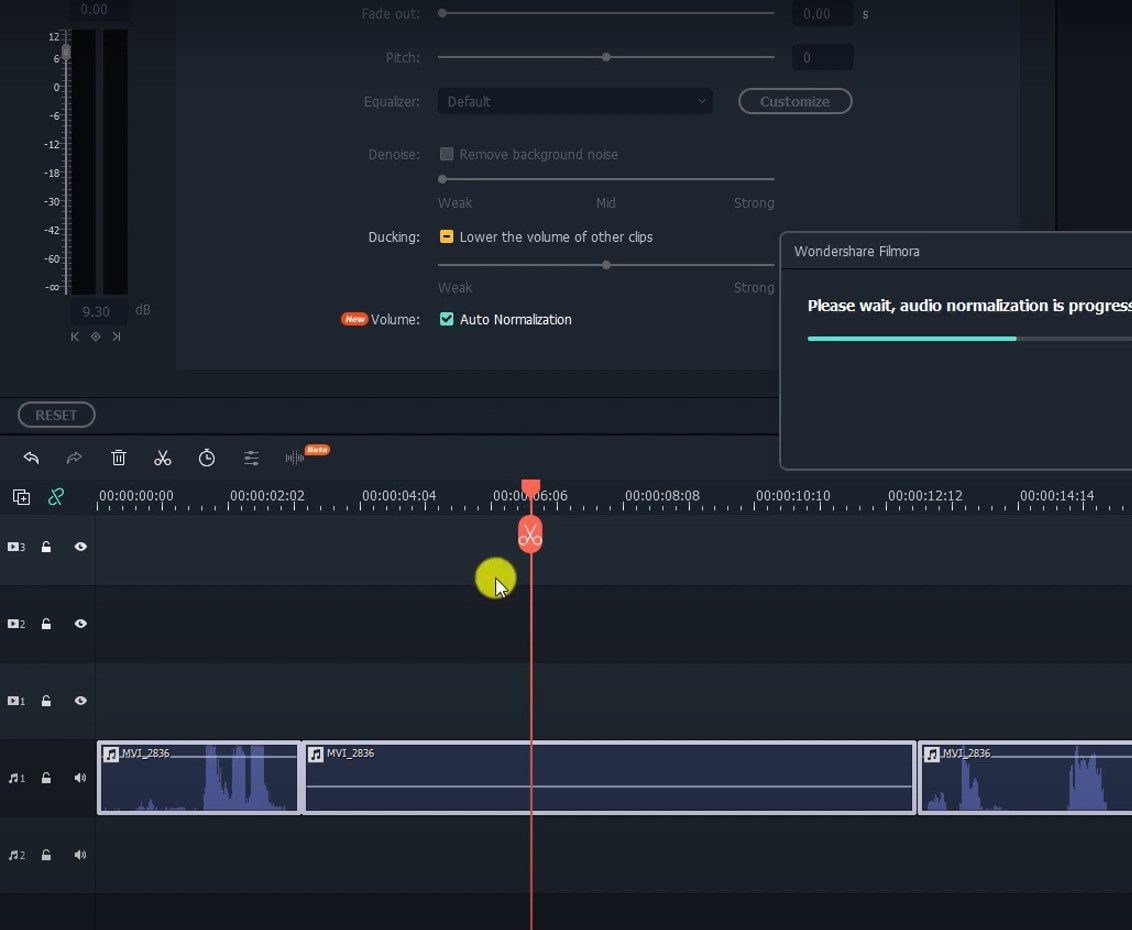
After you have clicked on it, wait until the normalization completes.

Soon, all audio will be normalized, and you will already be able to see on the graphics that the volumes are almost on the same level and when you listen to it, you will make sure that there is no longer apparent difference between how they sound. And from there on, you can save the file you just normalized!
So, in this article, we learned a lot about normalizing volumes, why and how it is done, and, more specifically, how to get this task completed in VLC Media Player as well as in Wondershare Filmora X. you can proceed to putting this new information into a good use and come back to learn more about video and audio editing here!
Free Download For macOS 10.14 or later
When it is done installing, open the software. Now, click and drag the video of which the audio you want to normalize. Now you can select the clip you have chosen – if there are multiple, select all of them, then right-click and choose Detach Audio.

Now if you have this kind of graphic before your eyes, you can be pretty sure without even listening, that the noises are really, really different from each other, which highlights once again how useful audio normalization can be:

Select these files, right-click and choose Adjust Audio. New panel will be opened on left top and there, you will see Audio Normalization – check the box there.


After you have clicked on it, wait until the normalization completes.

Soon, all audio will be normalized, and you will already be able to see on the graphics that the volumes are almost on the same level and when you listen to it, you will make sure that there is no longer apparent difference between how they sound. And from there on, you can save the file you just normalized!
So, in this article, we learned a lot about normalizing volumes, why and how it is done, and, more specifically, how to get this task completed in VLC Media Player as well as in Wondershare Filmora X. you can proceed to putting this new information into a good use and come back to learn more about video and audio editing here!
Incorporate Tune Into iMovie Video Composition
Versatile Video Editor - Wondershare Filmora
“Can you add songs to iMovie? I need someone who can help me find a solution by providing a Detailed Guide on how to add songs in iMovie.”
It is a fact that iMovie is free for Apple users. There is a bit of a learning process that a user needs to go through before they start using it. It is also pertinant to understand that the simple process of adding a song to iMovie can be pretty tough if you do not understand the process.
Without delaying any further, let’s go through a quick detailed guide on how to add songs on iMovie as follows:
In this article
01 [How to add Music to iMovie [iPhone & Mac]](#Part 1)
02 [Can I use iTunes songs on iMovie](#Part 2)
03 [Where can I get free songs to add to iMovie](#Part 3)
Part 1 How to add Music to iMovie [iPhone & Mac]
iMovie provides Apple users with varieties of great opportunities, especially those who are much more interested in making videos to add transitions, cut clips, overlay titles, and do more on the platform. More so, for those using them already, you will notice that there are about five songs already, which can be somewhat overwhelming.
The good news is that Apple users can now add more songs on iMovie using the following steps:
For iPhone: there are different methods of adding songs to the iMovie project using your iPhone device:
Add theme music and soundtrack
● While your project is still open, click on Add Media button +and then click on Audio.
● Click on Soundtracks and all the Soundtracks that you need to download will appear showing a Download button next to them.
● Click on a soundtrack you want to download and download it. After you download a soundtrack, you can click on it to preview.
● To download all the soundtracks, click on the Download button in the upper right.
● To add a soundtrack, click on the soundtrack you want to add and then click on the Add Audio option + that appears to add a soundtrack to your project.
● Scroll down to the Theme Music section available at the Soundtracks list and add theme music to your project to add theme music.
Add background song stored on your device
● While your project is still open, click on Add Media button + and click on Audio.
● To look for songs previously synced to your device from your computer, click on My Music.
● To listen to a song before adding them, click on the song.
● To add a song to your iMovie project, click on the song and then click on the Add Audio button +.
Add imported songs from an iCloud drive or other audio
Scroll the timeline so the white vertical line known as the ‘Playhead’ appears while your project is still open and select where you want to add the audio clip or songs.
Note: The new clip gets added before or after an existing clip. This is if the ‘Playhead’ is resting over a current clip.
● Click on Add Media + and then click on Audio.
● Click on the iCloud Drive listed in the categories.
● Navigate to the folder with the audio you want to use, located at the iCloud pane,
● Click on the name of the audio clip or song you want to add and tap the Add Audio button +.
For Mac: There are different methods of adding songs to the iMovie project using your Mac device:
Add background Music
● Click on the iMovie app on your Mac device and open your movie in the timeline. Then select Audio located above the browser.

Source
● In the audio sidebar, select from the dropdown; Sound Effects , GarageBand , or Music
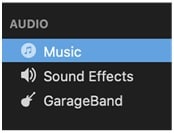
The contents found in the selected item will appear as a list in the browser. Therefore, to filter what appears as a list in the browser:
● Tap the pop-up menu at the upper-left corner and select a category.
● Look for the clip you want to add to your project in the browser.
● Drag and drop the clip to the background music well below the timeline.
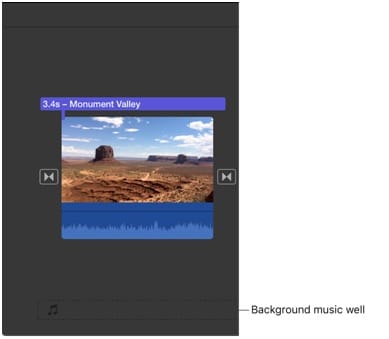
You can now trim, edit, and position, the background audio independently of clips in the timeline.
Add a sound clip
● Click on the iMovie app on your Mac device and open your movie in the timeline. Select Audio in the menu located above the browser.
● In the audio sidebar, select from the dropdown; Sound Effects , GarageBand , or Music
The contents found in the selected item will appear as a list in the browser. Now, to filter what appears as a list in the browser:
Tap the pop-up menu located at the upper-left corner of the browser and select a category.
In the browser, select the song you want to add to your movie and then do any of the following:
a) Add all audio clips by dragging the clip from the list to the timeline.
b) Add a part of the audio clip by selecting a range in the waveform at the top of the browser. Then drag the range to the timeline.

● Finally, the audio clip will then be attached to a clip in the timeline. Therefore, the audio clip will move as well if you move the clip the audio clip is linked to.
Source
Part 2 Can I use iTunes songs on iMovie
Before we know how to add songs from iTunes iMovie, you must realize that all Music is protected. You will get an error statement that; “the songs you selected are not usable in iMovie because they are DRM (which means Digital Rights Management) protected.”
Note that to use the songs you had downloaded from iTunes, you must be sure that they have copyright permission. Otherwise, you won’t be able to use such themes in iMovie as those downloaded content through iTunes come up with limited rights only. Available options are:
● Import music from iTunes to iMovie (Already existing, downloaded files)
● Can purchase the track from iTunes Store
● Rip the CD
● Purchase music from Amazon
● Subscribe for the program named ‘Match’ under iTunes (That will assist you in getting duplicate copies of DRM free music.)
Noted: You can use all those tracks you own, but not those tracks that you get on a rental basis (such as from Apple Music).
Alternatively, you have one more option: you can add songs to iMovie from Spotify. If you are willing to learn how to add songs to iMovie from Spotify, the process is quite simple. Firstly transfer your Spotify music/songs to your music library. Then open iMovie > Add media> Add Music and select your desired song/music/track from the library.
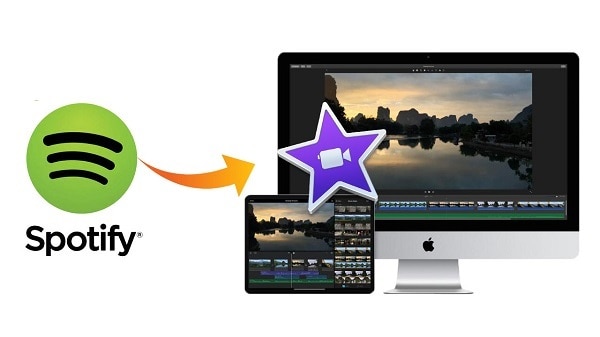
This way, you can easily add songs from Spotify to iMovie.
Part 3 Where can I get free songs to add to iMovie
To get and add songs in iMovie, you can visit the following free platform to download the songs on your device.
● dig.ccMixter

If you are looking to find some excellent soundtrack, Music to make the iMovie add song process smooth, then using this platform will be the right approach.
● HookSounds
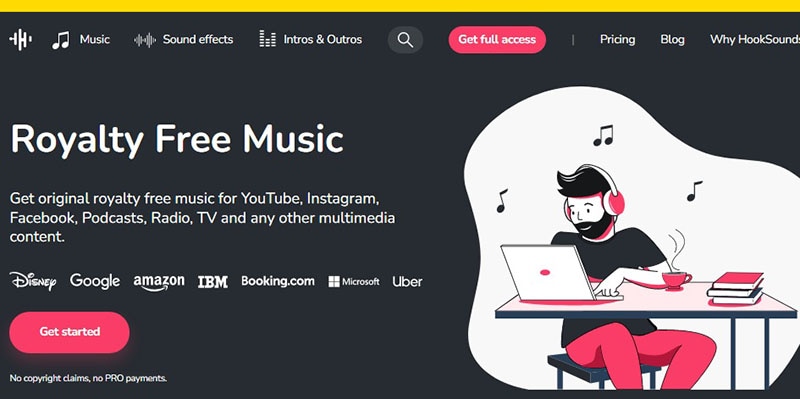
If you want to learn how to add a song on iMovie iPhone or Mac devices, getting Royalty-Free Resources will be the desired choice. And that choice you will get with HookSounds.
● Free sound
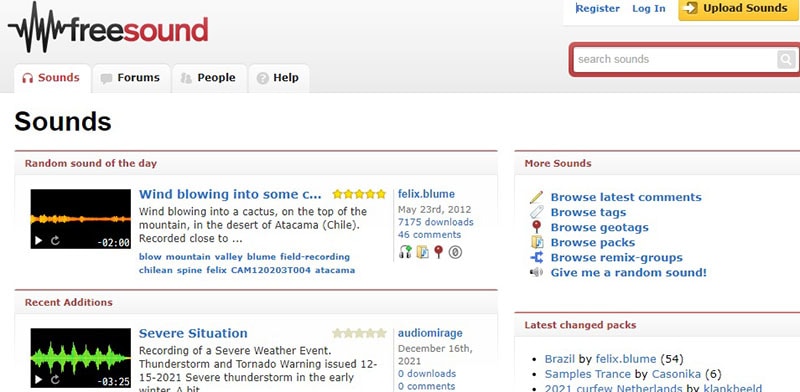
There is one more free music resource platform that will give you multiple options to get some incredible soundtracks for free so that you would be able to understand quickly how do you add songs to iMovie.
Conclusion
Listening to your favorite Music at your ease is the best thing in the world. Especially the freedom of Music, video editing with iMovie is a great relief to the iPhone, Mac users. But, the limited availability of Audio or songs under the iMovie library will reduce the expedition. And the question always arises how to add songs from Apple Music to iMovie or different ways to download iMovie add Songs. The article gives you a detailed description of how to add Songs to iMovie on Mac and how to add Songs to iMovie on iPhone devices with respective details. Additionally, the options given to free resources to download Music will provide you further guidance to enrich your music library with iMovie.
“Can you add songs to iMovie? I need someone who can help me find a solution by providing a Detailed Guide on how to add songs in iMovie.”
It is a fact that iMovie is free for Apple users. There is a bit of a learning process that a user needs to go through before they start using it. It is also pertinant to understand that the simple process of adding a song to iMovie can be pretty tough if you do not understand the process.
Without delaying any further, let’s go through a quick detailed guide on how to add songs on iMovie as follows:
In this article
01 [How to add Music to iMovie [iPhone & Mac]](#Part 1)
02 [Can I use iTunes songs on iMovie](#Part 2)
03 [Where can I get free songs to add to iMovie](#Part 3)
Part 1 How to add Music to iMovie [iPhone & Mac]
iMovie provides Apple users with varieties of great opportunities, especially those who are much more interested in making videos to add transitions, cut clips, overlay titles, and do more on the platform. More so, for those using them already, you will notice that there are about five songs already, which can be somewhat overwhelming.
The good news is that Apple users can now add more songs on iMovie using the following steps:
For iPhone: there are different methods of adding songs to the iMovie project using your iPhone device:
Add theme music and soundtrack
● While your project is still open, click on Add Media button +and then click on Audio.
● Click on Soundtracks and all the Soundtracks that you need to download will appear showing a Download button next to them.
● Click on a soundtrack you want to download and download it. After you download a soundtrack, you can click on it to preview.
● To download all the soundtracks, click on the Download button in the upper right.
● To add a soundtrack, click on the soundtrack you want to add and then click on the Add Audio option + that appears to add a soundtrack to your project.
● Scroll down to the Theme Music section available at the Soundtracks list and add theme music to your project to add theme music.
Add background song stored on your device
● While your project is still open, click on Add Media button + and click on Audio.
● To look for songs previously synced to your device from your computer, click on My Music.
● To listen to a song before adding them, click on the song.
● To add a song to your iMovie project, click on the song and then click on the Add Audio button +.
Add imported songs from an iCloud drive or other audio
Scroll the timeline so the white vertical line known as the ‘Playhead’ appears while your project is still open and select where you want to add the audio clip or songs.
Note: The new clip gets added before or after an existing clip. This is if the ‘Playhead’ is resting over a current clip.
● Click on Add Media + and then click on Audio.
● Click on the iCloud Drive listed in the categories.
● Navigate to the folder with the audio you want to use, located at the iCloud pane,
● Click on the name of the audio clip or song you want to add and tap the Add Audio button +.
For Mac: There are different methods of adding songs to the iMovie project using your Mac device:
Add background Music
● Click on the iMovie app on your Mac device and open your movie in the timeline. Then select Audio located above the browser.

Source
● In the audio sidebar, select from the dropdown; Sound Effects , GarageBand , or Music

The contents found in the selected item will appear as a list in the browser. Therefore, to filter what appears as a list in the browser:
● Tap the pop-up menu at the upper-left corner and select a category.
● Look for the clip you want to add to your project in the browser.
● Drag and drop the clip to the background music well below the timeline.

You can now trim, edit, and position, the background audio independently of clips in the timeline.
Add a sound clip
● Click on the iMovie app on your Mac device and open your movie in the timeline. Select Audio in the menu located above the browser.
● In the audio sidebar, select from the dropdown; Sound Effects , GarageBand , or Music
The contents found in the selected item will appear as a list in the browser. Now, to filter what appears as a list in the browser:
Tap the pop-up menu located at the upper-left corner of the browser and select a category.
In the browser, select the song you want to add to your movie and then do any of the following:
a) Add all audio clips by dragging the clip from the list to the timeline.
b) Add a part of the audio clip by selecting a range in the waveform at the top of the browser. Then drag the range to the timeline.

● Finally, the audio clip will then be attached to a clip in the timeline. Therefore, the audio clip will move as well if you move the clip the audio clip is linked to.
Source
Part 2 Can I use iTunes songs on iMovie
Before we know how to add songs from iTunes iMovie, you must realize that all Music is protected. You will get an error statement that; “the songs you selected are not usable in iMovie because they are DRM (which means Digital Rights Management) protected.”
Note that to use the songs you had downloaded from iTunes, you must be sure that they have copyright permission. Otherwise, you won’t be able to use such themes in iMovie as those downloaded content through iTunes come up with limited rights only. Available options are:
● Import music from iTunes to iMovie (Already existing, downloaded files)
● Can purchase the track from iTunes Store
● Rip the CD
● Purchase music from Amazon
● Subscribe for the program named ‘Match’ under iTunes (That will assist you in getting duplicate copies of DRM free music.)
Noted: You can use all those tracks you own, but not those tracks that you get on a rental basis (such as from Apple Music).
Alternatively, you have one more option: you can add songs to iMovie from Spotify. If you are willing to learn how to add songs to iMovie from Spotify, the process is quite simple. Firstly transfer your Spotify music/songs to your music library. Then open iMovie > Add media> Add Music and select your desired song/music/track from the library.

This way, you can easily add songs from Spotify to iMovie.
Part 3 Where can I get free songs to add to iMovie
To get and add songs in iMovie, you can visit the following free platform to download the songs on your device.
● dig.ccMixter

If you are looking to find some excellent soundtrack, Music to make the iMovie add song process smooth, then using this platform will be the right approach.
● HookSounds

If you want to learn how to add a song on iMovie iPhone or Mac devices, getting Royalty-Free Resources will be the desired choice. And that choice you will get with HookSounds.
● Free sound

There is one more free music resource platform that will give you multiple options to get some incredible soundtracks for free so that you would be able to understand quickly how do you add songs to iMovie.
Conclusion
Listening to your favorite Music at your ease is the best thing in the world. Especially the freedom of Music, video editing with iMovie is a great relief to the iPhone, Mac users. But, the limited availability of Audio or songs under the iMovie library will reduce the expedition. And the question always arises how to add songs from Apple Music to iMovie or different ways to download iMovie add Songs. The article gives you a detailed description of how to add Songs to iMovie on Mac and how to add Songs to iMovie on iPhone devices with respective details. Additionally, the options given to free resources to download Music will provide you further guidance to enrich your music library with iMovie.
“Can you add songs to iMovie? I need someone who can help me find a solution by providing a Detailed Guide on how to add songs in iMovie.”
It is a fact that iMovie is free for Apple users. There is a bit of a learning process that a user needs to go through before they start using it. It is also pertinant to understand that the simple process of adding a song to iMovie can be pretty tough if you do not understand the process.
Without delaying any further, let’s go through a quick detailed guide on how to add songs on iMovie as follows:
In this article
01 [How to add Music to iMovie [iPhone & Mac]](#Part 1)
02 [Can I use iTunes songs on iMovie](#Part 2)
03 [Where can I get free songs to add to iMovie](#Part 3)
Part 1 How to add Music to iMovie [iPhone & Mac]
iMovie provides Apple users with varieties of great opportunities, especially those who are much more interested in making videos to add transitions, cut clips, overlay titles, and do more on the platform. More so, for those using them already, you will notice that there are about five songs already, which can be somewhat overwhelming.
The good news is that Apple users can now add more songs on iMovie using the following steps:
For iPhone: there are different methods of adding songs to the iMovie project using your iPhone device:
Add theme music and soundtrack
● While your project is still open, click on Add Media button +and then click on Audio.
● Click on Soundtracks and all the Soundtracks that you need to download will appear showing a Download button next to them.
● Click on a soundtrack you want to download and download it. After you download a soundtrack, you can click on it to preview.
● To download all the soundtracks, click on the Download button in the upper right.
● To add a soundtrack, click on the soundtrack you want to add and then click on the Add Audio option + that appears to add a soundtrack to your project.
● Scroll down to the Theme Music section available at the Soundtracks list and add theme music to your project to add theme music.
Add background song stored on your device
● While your project is still open, click on Add Media button + and click on Audio.
● To look for songs previously synced to your device from your computer, click on My Music.
● To listen to a song before adding them, click on the song.
● To add a song to your iMovie project, click on the song and then click on the Add Audio button +.
Add imported songs from an iCloud drive or other audio
Scroll the timeline so the white vertical line known as the ‘Playhead’ appears while your project is still open and select where you want to add the audio clip or songs.
Note: The new clip gets added before or after an existing clip. This is if the ‘Playhead’ is resting over a current clip.
● Click on Add Media + and then click on Audio.
● Click on the iCloud Drive listed in the categories.
● Navigate to the folder with the audio you want to use, located at the iCloud pane,
● Click on the name of the audio clip or song you want to add and tap the Add Audio button +.
For Mac: There are different methods of adding songs to the iMovie project using your Mac device:
Add background Music
● Click on the iMovie app on your Mac device and open your movie in the timeline. Then select Audio located above the browser.

Source
● In the audio sidebar, select from the dropdown; Sound Effects , GarageBand , or Music

The contents found in the selected item will appear as a list in the browser. Therefore, to filter what appears as a list in the browser:
● Tap the pop-up menu at the upper-left corner and select a category.
● Look for the clip you want to add to your project in the browser.
● Drag and drop the clip to the background music well below the timeline.

You can now trim, edit, and position, the background audio independently of clips in the timeline.
Add a sound clip
● Click on the iMovie app on your Mac device and open your movie in the timeline. Select Audio in the menu located above the browser.
● In the audio sidebar, select from the dropdown; Sound Effects , GarageBand , or Music
The contents found in the selected item will appear as a list in the browser. Now, to filter what appears as a list in the browser:
Tap the pop-up menu located at the upper-left corner of the browser and select a category.
In the browser, select the song you want to add to your movie and then do any of the following:
a) Add all audio clips by dragging the clip from the list to the timeline.
b) Add a part of the audio clip by selecting a range in the waveform at the top of the browser. Then drag the range to the timeline.

● Finally, the audio clip will then be attached to a clip in the timeline. Therefore, the audio clip will move as well if you move the clip the audio clip is linked to.
Source
Part 2 Can I use iTunes songs on iMovie
Before we know how to add songs from iTunes iMovie, you must realize that all Music is protected. You will get an error statement that; “the songs you selected are not usable in iMovie because they are DRM (which means Digital Rights Management) protected.”
Note that to use the songs you had downloaded from iTunes, you must be sure that they have copyright permission. Otherwise, you won’t be able to use such themes in iMovie as those downloaded content through iTunes come up with limited rights only. Available options are:
● Import music from iTunes to iMovie (Already existing, downloaded files)
● Can purchase the track from iTunes Store
● Rip the CD
● Purchase music from Amazon
● Subscribe for the program named ‘Match’ under iTunes (That will assist you in getting duplicate copies of DRM free music.)
Noted: You can use all those tracks you own, but not those tracks that you get on a rental basis (such as from Apple Music).
Alternatively, you have one more option: you can add songs to iMovie from Spotify. If you are willing to learn how to add songs to iMovie from Spotify, the process is quite simple. Firstly transfer your Spotify music/songs to your music library. Then open iMovie > Add media> Add Music and select your desired song/music/track from the library.

This way, you can easily add songs from Spotify to iMovie.
Part 3 Where can I get free songs to add to iMovie
To get and add songs in iMovie, you can visit the following free platform to download the songs on your device.
● dig.ccMixter

If you are looking to find some excellent soundtrack, Music to make the iMovie add song process smooth, then using this platform will be the right approach.
● HookSounds

If you want to learn how to add a song on iMovie iPhone or Mac devices, getting Royalty-Free Resources will be the desired choice. And that choice you will get with HookSounds.
● Free sound

There is one more free music resource platform that will give you multiple options to get some incredible soundtracks for free so that you would be able to understand quickly how do you add songs to iMovie.
Conclusion
Listening to your favorite Music at your ease is the best thing in the world. Especially the freedom of Music, video editing with iMovie is a great relief to the iPhone, Mac users. But, the limited availability of Audio or songs under the iMovie library will reduce the expedition. And the question always arises how to add songs from Apple Music to iMovie or different ways to download iMovie add Songs. The article gives you a detailed description of how to add Songs to iMovie on Mac and how to add Songs to iMovie on iPhone devices with respective details. Additionally, the options given to free resources to download Music will provide you further guidance to enrich your music library with iMovie.
“Can you add songs to iMovie? I need someone who can help me find a solution by providing a Detailed Guide on how to add songs in iMovie.”
It is a fact that iMovie is free for Apple users. There is a bit of a learning process that a user needs to go through before they start using it. It is also pertinant to understand that the simple process of adding a song to iMovie can be pretty tough if you do not understand the process.
Without delaying any further, let’s go through a quick detailed guide on how to add songs on iMovie as follows:
In this article
01 [How to add Music to iMovie [iPhone & Mac]](#Part 1)
02 [Can I use iTunes songs on iMovie](#Part 2)
03 [Where can I get free songs to add to iMovie](#Part 3)
Part 1 How to add Music to iMovie [iPhone & Mac]
iMovie provides Apple users with varieties of great opportunities, especially those who are much more interested in making videos to add transitions, cut clips, overlay titles, and do more on the platform. More so, for those using them already, you will notice that there are about five songs already, which can be somewhat overwhelming.
The good news is that Apple users can now add more songs on iMovie using the following steps:
For iPhone: there are different methods of adding songs to the iMovie project using your iPhone device:
Add theme music and soundtrack
● While your project is still open, click on Add Media button +and then click on Audio.
● Click on Soundtracks and all the Soundtracks that you need to download will appear showing a Download button next to them.
● Click on a soundtrack you want to download and download it. After you download a soundtrack, you can click on it to preview.
● To download all the soundtracks, click on the Download button in the upper right.
● To add a soundtrack, click on the soundtrack you want to add and then click on the Add Audio option + that appears to add a soundtrack to your project.
● Scroll down to the Theme Music section available at the Soundtracks list and add theme music to your project to add theme music.
Add background song stored on your device
● While your project is still open, click on Add Media button + and click on Audio.
● To look for songs previously synced to your device from your computer, click on My Music.
● To listen to a song before adding them, click on the song.
● To add a song to your iMovie project, click on the song and then click on the Add Audio button +.
Add imported songs from an iCloud drive or other audio
Scroll the timeline so the white vertical line known as the ‘Playhead’ appears while your project is still open and select where you want to add the audio clip or songs.
Note: The new clip gets added before or after an existing clip. This is if the ‘Playhead’ is resting over a current clip.
● Click on Add Media + and then click on Audio.
● Click on the iCloud Drive listed in the categories.
● Navigate to the folder with the audio you want to use, located at the iCloud pane,
● Click on the name of the audio clip or song you want to add and tap the Add Audio button +.
For Mac: There are different methods of adding songs to the iMovie project using your Mac device:
Add background Music
● Click on the iMovie app on your Mac device and open your movie in the timeline. Then select Audio located above the browser.

Source
● In the audio sidebar, select from the dropdown; Sound Effects , GarageBand , or Music

The contents found in the selected item will appear as a list in the browser. Therefore, to filter what appears as a list in the browser:
● Tap the pop-up menu at the upper-left corner and select a category.
● Look for the clip you want to add to your project in the browser.
● Drag and drop the clip to the background music well below the timeline.

You can now trim, edit, and position, the background audio independently of clips in the timeline.
Add a sound clip
● Click on the iMovie app on your Mac device and open your movie in the timeline. Select Audio in the menu located above the browser.
● In the audio sidebar, select from the dropdown; Sound Effects , GarageBand , or Music
The contents found in the selected item will appear as a list in the browser. Now, to filter what appears as a list in the browser:
Tap the pop-up menu located at the upper-left corner of the browser and select a category.
In the browser, select the song you want to add to your movie and then do any of the following:
a) Add all audio clips by dragging the clip from the list to the timeline.
b) Add a part of the audio clip by selecting a range in the waveform at the top of the browser. Then drag the range to the timeline.

● Finally, the audio clip will then be attached to a clip in the timeline. Therefore, the audio clip will move as well if you move the clip the audio clip is linked to.
Source
Part 2 Can I use iTunes songs on iMovie
Before we know how to add songs from iTunes iMovie, you must realize that all Music is protected. You will get an error statement that; “the songs you selected are not usable in iMovie because they are DRM (which means Digital Rights Management) protected.”
Note that to use the songs you had downloaded from iTunes, you must be sure that they have copyright permission. Otherwise, you won’t be able to use such themes in iMovie as those downloaded content through iTunes come up with limited rights only. Available options are:
● Import music from iTunes to iMovie (Already existing, downloaded files)
● Can purchase the track from iTunes Store
● Rip the CD
● Purchase music from Amazon
● Subscribe for the program named ‘Match’ under iTunes (That will assist you in getting duplicate copies of DRM free music.)
Noted: You can use all those tracks you own, but not those tracks that you get on a rental basis (such as from Apple Music).
Alternatively, you have one more option: you can add songs to iMovie from Spotify. If you are willing to learn how to add songs to iMovie from Spotify, the process is quite simple. Firstly transfer your Spotify music/songs to your music library. Then open iMovie > Add media> Add Music and select your desired song/music/track from the library.

This way, you can easily add songs from Spotify to iMovie.
Part 3 Where can I get free songs to add to iMovie
To get and add songs in iMovie, you can visit the following free platform to download the songs on your device.
● dig.ccMixter

If you are looking to find some excellent soundtrack, Music to make the iMovie add song process smooth, then using this platform will be the right approach.
● HookSounds

If you want to learn how to add a song on iMovie iPhone or Mac devices, getting Royalty-Free Resources will be the desired choice. And that choice you will get with HookSounds.
● Free sound

There is one more free music resource platform that will give you multiple options to get some incredible soundtracks for free so that you would be able to understand quickly how do you add songs to iMovie.
Conclusion
Listening to your favorite Music at your ease is the best thing in the world. Especially the freedom of Music, video editing with iMovie is a great relief to the iPhone, Mac users. But, the limited availability of Audio or songs under the iMovie library will reduce the expedition. And the question always arises how to add songs from Apple Music to iMovie or different ways to download iMovie add Songs. The article gives you a detailed description of how to add Songs to iMovie on Mac and how to add Songs to iMovie on iPhone devices with respective details. Additionally, the options given to free resources to download Music will provide you further guidance to enrich your music library with iMovie.
Optimal Audio Tuning Parameters for Gadgets
When you use your device for listening to music, default audio profile of your device is just not good enough. This is because a default audio profile makes almost all types of music sound similar and you will never get to listen to the variations they have. That is where an equalizer comes into the scene. An equalizer is basically an audio filter or profile that has a certain setting for the frequencies of sound so that the music you are playing on your device sounds as good as originally recorded.
Whether you listen to music on your smartphone or your computer through speakers or headphones, an equalizer app is a necessity especially if you are an audiophile. That is why we have picked the best sound equalizer apps both for smartphones and computers where there are several music equalizer settings available to choose from.
1. Best Chrome Sound Equalizer Settings
If you are a Chrome browser user and you use online audio and video streaming platforms to play music, you must have Equalizer for Chrome Browser extension installed. The extension comes with 21 preset audio profiles that you can set instantly based on the music genre you are playing. Besides, you can customize the 10-band Equalizer as per your requirements.
Most importantly, it does not require heavy resources to run in the background unlike the desktop equalizer applications. The extension is completely free to use. Here are the steps how to use the extension for the best music equalizer settings for Google Chrome.
Step 1: On Google Chrome, visit “https://chrome.google.com/webstore/detail/equalizer-for-chrome-brow” .
Step 2: Click on Add To Chrome button and follow the on-screen instruction to install the extension successfully.
Step 3: Open your audio or video streaming platform on your browser and play the desired music.
Step 4: Open Equalizer for Chrome browser extension and select from preset equalizers or customizer as per your requirement and listen to the changes in real-time.

2. Best iPhone Equalizer Settings (https://apps.apple.com/us/app/equalizer-fx-bass-booster-app/id1084228340 )
Equalizer Fx - Bass Booster App is the most popular equalizer app for iPhones. It features a 7-band equalizer that you can customize as per your requirement. Besides, there is dynamic bass tuning option to enhance your listening experience. Moreover, it comes with a powerful bass boost effect if you love beats and bass on your music. The app has an advanced music layer and therefore, you do not need an external music player app.
There are over 15 preset filters available to choose from as you play music in the background to reflect the effects. You can keep your tracks on your device properly in an organized way for easy playing. Even though the app comes free, there is a subscription option available for advanced users to unlock more features and take their music listening experience to the next level.

3. Android Setting Equalizer for Best Sound (https://play.google.com/store/apps/details?id=com.devdnua.equalizer.free )
Equalizer FX - Sound Enhancer is a completely free app where you get as many as 12 preset equalizer settings for listening to different types of music with the best possible audio output. You can always tweak with the equalizer settings to get the perfect music you are looking for. The app features a loudness enhancer to amplify the volume on your device speaker or headphones without cracking it.
Moreover, you get a bass booster which is quite popular among music lovers. The app can also enhance the stereo effects for an immersive listening experience. The equalizer widget on the home screen makes it easy for users to operate the app. It automatically gets turned on and off when the music player starts and stops. The only drawback is that it does not work with radio.

4. Best Sound Equalizer for PC
Boom 3D is the most popular equalizer setting application among desktop users. The software is available for both Mac and Windows users. It is extremely popular for creating 3D surround effect in advanced speakers and headphones. The software has the most accurate and useful equalizer presets such as gaming, old songs, regular, vocals and much more.
Most importantly, it features an 11-band equalizer setting to customize as per your requirement. You can turn on and off the equalizer instantly and you can tweak with different audio parameters such as pitch, ambience, fidelity and much more. You can get a free trial after which you have to upgrade to its premium version. Here are the steps to use Boom 3D sound equalizer Windows 10 and macOS to get the best settings for equalizer.
Step 1: Download and install Boom 3D on your PC based on your operating system. Open the application and sign up to get started.
Step 2: If you are using headphones, select your headphone type for better results.

Step 3: Go to Equalizer tab and set any preset equalizer setting as per your requirement.
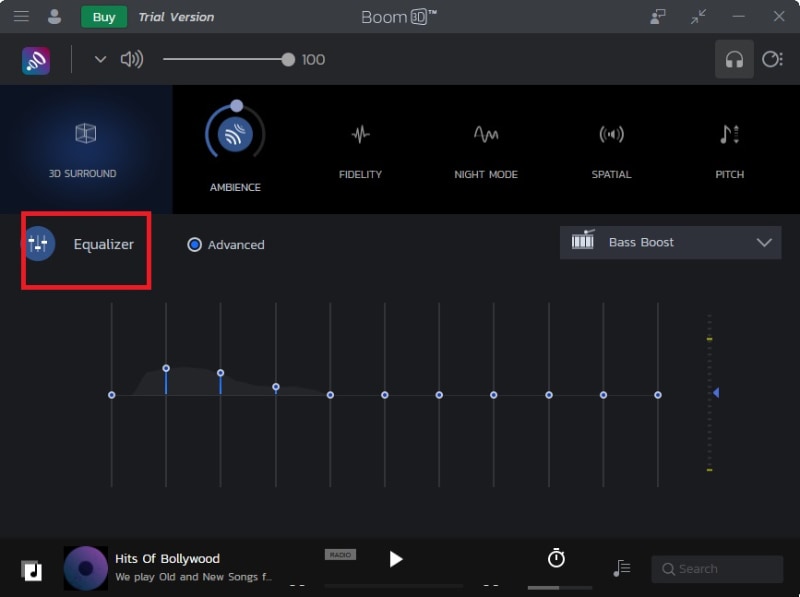
Step 4: Go to Advanced tab top customizer equalizer and the changes will reflect if you are playing anything on the background.

Bonus: How To Get The Best Setting For Equalizer For Any Audio File
If you have downloaded any audio or video file and you want to change the audio profile of the file by customizing its equalizer settings, you need a professional video editor with audio editing feature. We recommend Wondershare Filmora where you can enhance the sound profile of any audio or video file using equalizer settings as well as customize equalizer settings as per your requirements. Here are the steps to use Filmora to apply preset equalizer as well as customize equalizer.
For Win 7 or later (64-bit)
For macOS 10.12 or later
Step 1: Download and install Wondershare Filmora on your Mac or Windows PC.
Step 2: Select New project and go to File > Import Media and click on Import Media Files.
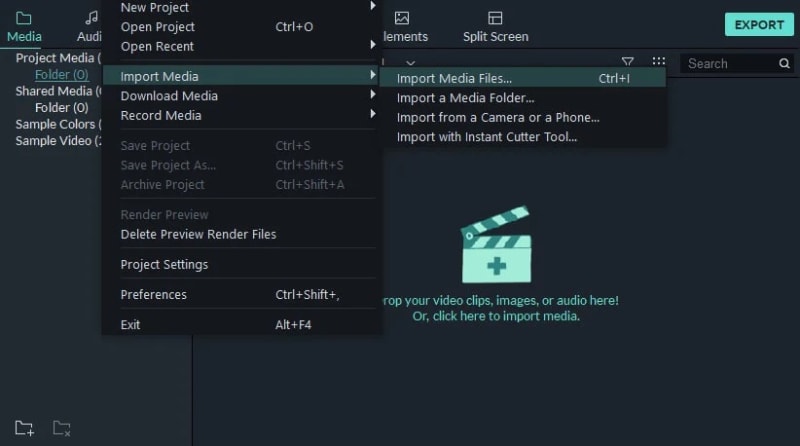
Step 3: Select the audio or the video file that you want to work with and then drag the file from Project Media to Timeline.
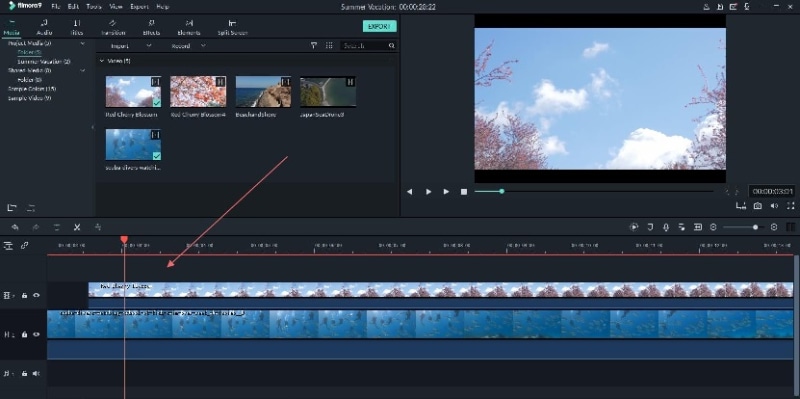
Step 4: Double-click on the file from the Timeline and go to Audio tab.
Step 5: Select from preset equalizers. You can also click on Customize button and make modifications as you think appropriate.
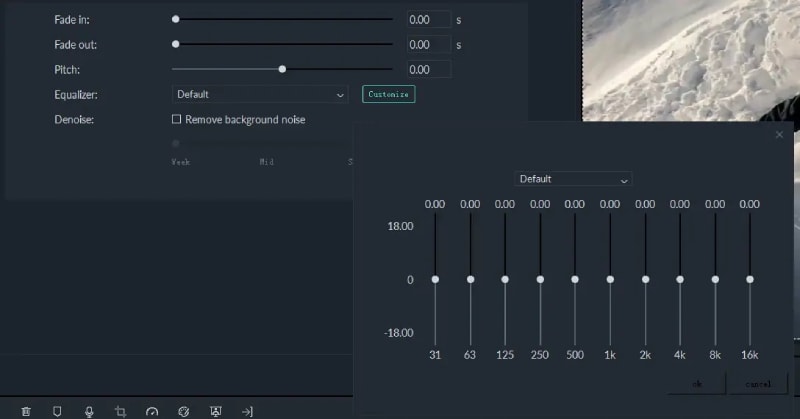
Conclusion –
We have provided you with the best apps with the best settings for equalizer. You can choose from the preset equalizer settings as well as customize and make your own equalizer settings. If you do not want to download any app and you are listening to music on your Chrome browser, you can use the browser extension. If you want permanent changes in equalizer settings to any downloaded audio or video, we recommend Wondershare Filmora for the best result.
For macOS 10.12 or later
Step 1: Download and install Wondershare Filmora on your Mac or Windows PC.
Step 2: Select New project and go to File > Import Media and click on Import Media Files.

Step 3: Select the audio or the video file that you want to work with and then drag the file from Project Media to Timeline.

Step 4: Double-click on the file from the Timeline and go to Audio tab.
Step 5: Select from preset equalizers. You can also click on Customize button and make modifications as you think appropriate.

Conclusion –
We have provided you with the best apps with the best settings for equalizer. You can choose from the preset equalizer settings as well as customize and make your own equalizer settings. If you do not want to download any app and you are listening to music on your Chrome browser, you can use the browser extension. If you want permanent changes in equalizer settings to any downloaded audio or video, we recommend Wondershare Filmora for the best result.
For macOS 10.12 or later
Step 1: Download and install Wondershare Filmora on your Mac or Windows PC.
Step 2: Select New project and go to File > Import Media and click on Import Media Files.

Step 3: Select the audio or the video file that you want to work with and then drag the file from Project Media to Timeline.

Step 4: Double-click on the file from the Timeline and go to Audio tab.
Step 5: Select from preset equalizers. You can also click on Customize button and make modifications as you think appropriate.

Conclusion –
We have provided you with the best apps with the best settings for equalizer. You can choose from the preset equalizer settings as well as customize and make your own equalizer settings. If you do not want to download any app and you are listening to music on your Chrome browser, you can use the browser extension. If you want permanent changes in equalizer settings to any downloaded audio or video, we recommend Wondershare Filmora for the best result.
For macOS 10.12 or later
Step 1: Download and install Wondershare Filmora on your Mac or Windows PC.
Step 2: Select New project and go to File > Import Media and click on Import Media Files.

Step 3: Select the audio or the video file that you want to work with and then drag the file from Project Media to Timeline.

Step 4: Double-click on the file from the Timeline and go to Audio tab.
Step 5: Select from preset equalizers. You can also click on Customize button and make modifications as you think appropriate.

Conclusion –
We have provided you with the best apps with the best settings for equalizer. You can choose from the preset equalizer settings as well as customize and make your own equalizer settings. If you do not want to download any app and you are listening to music on your Chrome browser, you can use the browser extension. If you want permanent changes in equalizer settings to any downloaded audio or video, we recommend Wondershare Filmora for the best result.
Also read:
- [New] From Jarring Cuts to Elegant Edits Unlocking Inshot's Transition Secrets
- [New] Prime Soundstage Narratives for Radio
- [Updated] 2024 Approved Saving Social Media Stories Chromes' Top 5 Tools
- [Updated] Mastering Multi-Image Compositions Photo Montages Guide
- [Updated] Simplifying the Process Recording on Xbox One
- Audio Removal Guide for MP4 Files for 2024
- Elevate Your Gaming Soundscape Techniques for Implementing Audio with KineMaster
- Fast Fix: Restoring Your Files From an Unresponsive Windows 11 System
- In 2024, How does the stardust trade cost In pokemon go On Apple iPhone 14 Plus? | Dr.fone
- In 2024, Which Pokémon can Evolve with a Moon Stone For Honor X8b? | Dr.fone
- Navigating Through This Years Top Ten Budget-Friendly Browser-Based DAW Solutions
- New 2024 Approved Proven 7 Audio Processors to Peacefully Remove Populated Sounds From Media
- New Converging Sound and Vision Top-Tier Tips for Effortless Audio-Video Alignment Automatically for 2024
- New In 2024, Enhancing Sound Quality Implementing Audio Ducking Techniques in Adobe Premiere Pro for Mac Users
- New In 2024, Perfecting Production Quality Utilizing Real-Time Ducking Features in Windows Adobe Premiere Pro Edition
- Reigniting Your Computer's Print Functionality with Effective WWin Solutions
- Title: Normalizing Volume in VLC A Step-by-Step Guide for 2024
- Author: Jacob
- Created at : 2024-10-27 20:08:49
- Updated at : 2024-10-29 17:11:58
- Link: https://audio-shaping.techidaily.com/normalizing-volume-in-vlc-a-step-by-step-guide-for-2024/
- License: This work is licensed under CC BY-NC-SA 4.0.